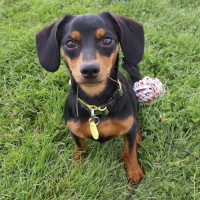Appearance of the Doxie-Pin
|
| The Doxie-Pin is a small-to-medium-sized hybrid between the Dachshund and the Miniature Pinscher. Your new furry addition will develop characteristics resembling both parent breeds, which are surprisingly similar. The coat is generally black and tan, but can vary from red to chocolate, depending on the parent breed. The ears are large and set lower on the head, and the nose is a little larger than that of the Dwarf Pinscher and is black. This little dynamo has a less exaggerated look than the Dachshund, with sturdy legs and a slightly longer body than the Miniature Pinscher. This inquisitive dog's tail is carried at back level and looks like a rope when not docked, but it can also stand up when the dog is excited, just like the Miniature Pinscher parent. |
Temperament of the Doxie-Pin
|
| The Doxie-Pin has a high-energy temperament, like the Miniature Pinscher parent, and can often be shy. The Dachshund parent adds a more even temperament to the Doxie-Pin and a calmer nature than the very nervous Miniature Pinscher. This friendly puppy loves company and you can find him on your lap most of the time. They can be wary of strangers and generally only bark in alarm. Otherwise, this hybrid is quiet. This mix is intelligent but can sometimes be a little stubborn. The Dachshund parent means that this eager-to-learn dog may respond well to training, but a reward will make the job easier and the dog more cooperative. |
Needs and activities of the Doxie-Pin
|
| The Doxie-Pin is an active dog, but does not require high-intensity exercise. A 30-minute walk twice a day is enough to satisfy them. A run in the backyard, chasing a ball will exercise both mind and body. If properly exercised, your Doxie-Pin will be easy to keep indoors and adapt to apartment life. Dwarf Pinschers, like Dachshunds, are known to love digging and exploring. Physical and mental stimulation are therefore necessary to keep your companion satisfied. They are an all-weather hybrid and can do well in both cold and warm climates, provided they are not too extreme. Temperate climates and homes with backyards are ideal for this small to medium-sized hybrid. |
Maintenance of the Doxie-Pin
|
| Both the Dachshund and the Miniature Pinscher are considered weak to moderate excretors, and the Doxie-Pin won't shed much. However, this hybrid is not a hypoallergenic dog. Regular brushing will keep this hybrid fit and well, and bathing is not recommended due to the sensitivity of its skin. Instead of a full bath, some owners choose to use a warm washcloth or a wet wipe designed for dogs to remove mud, dirt or other substances. This specific crossbreed inherits the larger, floppy ears of the Dachshund parent and will require cleaning to remove any dirt, debris or wax. Regular teeth cleaning will also prevent gum and tooth disease and keep your dog's teeth and breath clean. |









 English (United Kingdom)
English (United Kingdom)